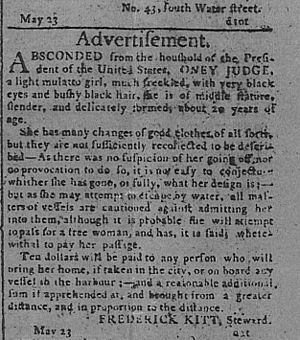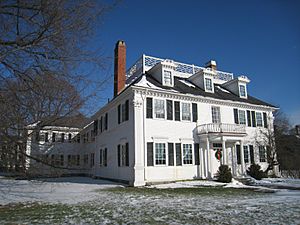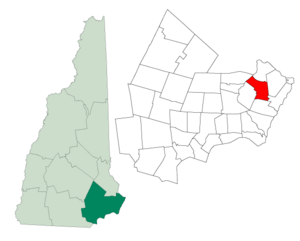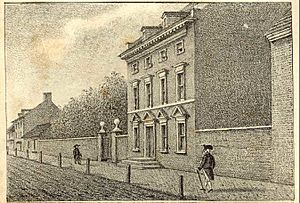Oney Judge facts for kids
Quick facts for kids
Ona "Oney" Judge Staines
|
|
|---|---|

Advertisement in The Pennsylvania Gazette (Philadelphia), May 24, 1796
|
|
| Born | c. 1773 |
| Died | February 25, 1848 (aged 75) Greenland, New Hampshire, U.S.
|
| Spouse(s) | Jack Staines |
| Children | Eliza Staines Nancy Staines Will Staines |
| Parent(s) | Andrew Judge Betty |
| Relatives | Austin (half-brother) Tom Davis (half-brother) Betty Davis (half-sister) Delphy (half-sister) |
Ona "Oney" Judge Staines (c. 1773 – February 25, 1848) was an enslaved woman. She was owned by the Washington family. First, she lived at their plantation, Mount Vernon. Later, when George Washington became president, she lived at the President's House in Philadelphia. Philadelphia was the nation's capital city at that time.
When she was in her early twenties, Ona learned that Martha Washington planned to give her to her granddaughter. This granddaughter was known for having a very bad temper. So, Ona ran away, becoming a fugitive slave. She fled to New Hampshire. There, she got married, had children, and became a Christian. The Washington family tried to get her back for years. However, they did not want to risk public anger. They eventually stopped trying to force her to return. Ona Judge was never legally freed, but she lived the rest of her life in freedom.
| Top - 0-9 A B C D E F G H I J K L M N O P Q R S T U V W X Y Z |
Ona Judge's Early Life
Ona Judge was born around 1773 at Mount Vernon. This was the large estate of George Washington and his family. Her mother, Betty, was an enslaved woman. Her father, Andrew Judge, was a white English tailor. He worked at Mount Vernon as an indentured servant. This meant he worked for a set time to pay off a debt.
Even though Ona was mostly of European background, she was born into slavery. This was because of a law called partus sequitur ventrem. This law said that a child's status (enslaved or free) followed the mother's status. So, if the mother was enslaved, the child was also enslaved.
Ona had several half-siblings. Her mother, Betty, was one of 285 enslaved people. These people were owned by Martha Washington's first husband, Daniel Parke Custis. When he died, Martha received a "dower share" of his wealth. This included about 85 enslaved people. Martha could use these "dower slaves" but could not free or sell them. They belonged to the Custis estate.
When Martha married George Washington in 1759, Betty and her infant son, Austin, moved to Mount Vernon with her. Because Betty was enslaved by the Custis Estate, her children—Austin, Ona, and Delphy—were also owned by the Custis Estate. Ona's father, Andrew Judge, moved away after his work contract ended. He did not stay in touch with his family.
Ona eventually became Martha Washington's personal helper. In an interview in 1846, Ona said she did not receive any education or religious teaching from the Washingtons. In 1796, with help from Philadelphia's free black community, Ona escaped. She lived as a fugitive slave in New Hampshire for the rest of her life. We know more about Ona than most other enslaved people at Mount Vernon. This is because she was interviewed twice by newspapers that supported ending slavery in the 1840s.
Life in the Presidential Households
In 1789, George Washington became president. He took seven enslaved people, including Ona, to New York City. New York was the nation's capital at the time. They worked in his presidential home. In 1790, the capital moved to Philadelphia. Ona was one of nine enslaved people Washington took to work in the President's House there.
The Gradual Abolition Act
In 1780, Pennsylvania passed the Gradual Abolition Act. This was the first state law to set up a way to free enslaved people. However, no one was freed right away. The process would take many years.
The law immediately stopped the import of enslaved people into Pennsylvania. It also required owners to register the enslaved people they already had each year. If an owner did not register them, the enslaved people would be taken and freed. But if they were registered, they would remain enslaved for life. Any child born to an enslaved mother after the law passed would have to work for the mother's owner until age 28. After that, the child would be free.
The law also said that slaveholders from other states could stay in Pennsylvania with their enslaved people for up to six months. If the enslaved people stayed longer than six months, the law allowed them to become free. Members of Congress were exempt from this rule.
In 1788, the law was updated to close loopholes. For example, it stopped Pennsylvania owners from taking a pregnant enslaved woman out of state so her child would be born enslaved. It also stopped non-resident owners from rotating their enslaved people in and out of the state. This rotation was done to prevent them from reaching the six-month residency needed for freedom. This rule would become important for Ona Judge and others in the President's household.
When the capital moved to Philadelphia in 1790, it was unclear if Pennsylvania's slavery laws applied to federal officials. Washington believed he was still a resident of Virginia. He argued he should not be bound by Pennsylvania's slavery laws. To avoid the six-month rule, Washington secretly rotated the enslaved people in and out of Pennsylvania. He would send them back to Mount Vernon or to nearby New Jersey before the six-month deadline. He also made sure he never stayed in Pennsylvania for six continuous months himself.
In 1791, a proposal to exempt all federal officials from the Gradual Abolition Act failed. This was due to strong opposition from groups working to end slavery. Later, in 1842, the U.S. Supreme Court ruled that the part of Pennsylvania's law allowing enslaved people of non-residents to be freed was unconstitutional.
Ona Judge's Escape
Ona Judge ran away as the Washingtons were getting ready to go back to Virginia. Martha Washington had told Ona that she would be given to Martha's granddaughter, Elizabeth Parke Custis Law. This granddaughter was known for her fierce temper.
In an interview in 1845, Ona remembered:
Whilst they were packing up to go to Virginia, I was packing to go, I didn't know where; for I knew that if I went back to Virginia, I should never get my liberty. I had friends among the colored people of Philadelphia, had my things carried there beforehand, and left Washington's house while they were eating dinner.
Newspaper ads in Philadelphia show that Ona escaped on May 21, 1796. An ad in The Philadelphia Gazette on May 24, 1796, described her. It offered a reward for her return. It warned ship captains not to let her on board.
Life in New Hampshire

Ona Judge secretly boarded a ship called the Nancy. It was headed for Portsmouth, New Hampshire. She might have thought she was safe there. However, that summer, Elizabeth Langdon recognized her on the streets of Portsmouth. Elizabeth was the daughter of Senator John Langdon and a friend of Nelly Custis.
By September 1, Washington knew where Ona was. He wrote to the Secretary of the Treasury, Oliver Wolcott Jr., asking for her to be captured. Joseph Whipple, a customs official in Portsmouth, interviewed Ona. He warned that trying to kidnap her could cause a riot. Whipple refused to put Ona on a ship against her will. He told Wolcott that Ona would return voluntarily if the Washingtons promised to free her after their deaths.
Ona told Whipple that "a thirst for compleat freedom" was her only reason for running away. Washington was angry. He refused her offer. He said it would be wrong to reward her "unfaithfulness" with early freedom. He worried it would make other enslaved people unhappy.
Washington could have used the Fugitive Slave Act of 1793 to get Ona back. This law allowed slaveholders to reclaim escaped enslaved people across state lines. However, any court case would be public. Washington did not want that attention.
Washington left the presidency in 1797. In 1799, he asked his nephew, Burwell Bassett Jr., to help capture Ona. Bassett went to New Hampshire in September. Ona was married to a sailor named Jack Staines and had an infant. She refused to return to Virginia. Bassett stayed at Senator Langdon's house. He revealed his plan to kidnap Ona. This time, Langdon helped Ona. He secretly warned her to hide immediately. Bassett returned to Virginia without her.
After Ona escaped, her younger sister, Delphy, was given to Martha Washington's granddaughter. Delphy and her children were later freed in 1807.
Ona Judge's Family

In New Hampshire, Ona Judge met and married Jack Staines. He was a free black sailor. They married in January 1797. Their marriage was recorded in the town records of Greenland, New Hampshire. They had three children:
- Eliza Staines (born 1798, died February 14, 1832)
- Will Staines (born 1801, death date unknown)
- Nancy Staines (born 1802, died February 11, 1833)
In freedom, Ona learned to read and became a Christian. She and Jack were married for less than seven years. He died on October 19, 1803. As a widow, Ona could not support her children. She moved in with the family of John Jacks Jr. Her daughters, Eliza and Nancy, became "wards of the town." This meant the town looked after them. They were hired out as indentured servants. Her son, Will, was apprenticed as a sailor.
Ona Judge's daughters died before she did. Her son reportedly never returned to Portsmouth. Later in life, Ona and the Jacks sisters were too old to work. Rockingham County helped them with firewood and other supplies.
Interviews About Slavery
Interviews with Ona Judge Staines were published in two newspapers. One was The Granite Freeman in May 1845. The other was The Liberator in January 1847. Both were abolitionist newspapers, meaning they supported ending slavery.
These interviews shared many details about her life. She talked about the Washingtons and their attempts to capture her. She also shared her thoughts on slavery, her pride in learning to read, and her strong religious faith. When asked if she regretted leaving the Washingtons, even though she worked harder after escaping, she said: "No, I am free, and have, I trust, been made a child of God by the means."
Ona Judge Was Never Legally Freed
George Washington died on December 14, 1799. In his will, he said that his 124 enslaved people should be freed after his wife's death. Martha Washington signed a document in December 1800. This document freed those enslaved people on January 1, 1801. However, the 153 "dower slaves" at Mount Vernon remained enslaved. Neither George nor Martha could legally free them.
After Martha Washington died in 1802, the dower slaves went back to the Custis estate. They were then divided among Martha's grandchildren. Ona Judge Staines remained a dower slave her whole life. Legally, her children were also dower slaves, even though their father, Jack Staines, was a free man. This was because of the partus sequitur ventrem principle.
The Fugitive Slave Act of 1793 was signed into law by Washington. This law allowed slaveholders to legally get back their "property." It made it a federal crime to help an escaped enslaved person. It also allowed slave-catchers to go into any U.S. state or territory.
After Washington's death, Ona Judge Staines probably felt safe in New Hampshire. No one else in her family was likely to try to take her. But legally, she and her children remained fugitives until they died. Her daughters died more than ten years before she did. It is not known what happened to her son.
Ona Judge Staines died in Greenland, New Hampshire, on February 25, 1848.
Legacy and Honors
On February 25, 2008, Philadelphia celebrated the first "Oney Judge Day." This was the 160th anniversary of her death. The event took place at the President's House site. It included speeches by historians and activists. The mayor, Michael A. Nutter, made a proclamation. The City Council also gave a memorial citation.
"Oney Judge Freedom Day" was celebrated on May 21, 2010. This was the 214th anniversary of her escape. The President's House Commemoration opened in December 2010. It is located at 6th & Market Streets in Philadelphia. It includes a video about Ona Judge. It also has information about all nine enslaved people held at the house. The site also honors the contributions of African Americans to Philadelphia and the U.S.
On June 19, 2021, (Juneteenth), a Virginia State Historical Marker honoring Ona Judge was unveiled. It is near the Mount Vernon estate, on the Mount Vernon Memorial Highway.
In Popular Culture
Books
- Taking Liberty (2002), a novel by Ann Rinaldi
- The Escape of Oney Judge (2007), a children's book by Emily Arnold McCully
- My Name Is Oney Judge (2010), a children's book by Diane D. Turner
- Oney: My Escape From Slavery (2017), a novel by Diana Rubino and Piper Huguley
- Never Caught: The Washingtons' Relentless Pursuit of Their Runaway Slave, Ona Judge (2017), a biography by Erica Armstrong Dunbar
- Never Caught, the Story of Ona Judge: George and Martha Washington's Courageous Slave Who Dared to Run Away (2017), Young Readers Edition by Erica Armstrong Dunbar and Kathleen Van Cleve
- My Name is Ona Judge (2022), a novel by Suzette D. Harrison
Theater
- A Thirst for Freedom (2000), a play by Emory Wilson. It was produced at The Players' Ring Theater, Portsmouth, New Hampshire.
- A House with No Walls (2007), a play by Thomas Gibbons. It was first produced at InterAct Theatre Company, Philadelphia, Pennsylvania.
- Parallel Destinies (2010), a dance/theater piece by Germaine Ingram, Bobby Zankel, and John Dowell.
Video
- The Freedom Quest of Oney Judge (2015), a video by HERO Live! Colonial Williamsburg helps teach American history to students. This program uses modern technology and actors to tell historical stories.
See Also
- List of enslaved people of Mount Vernon
- George Washington and slavery
- Samuel Osgood House — First Presidential Mansion
- Alexander Macomb House — Second Presidential Mansion
- List of enslaved people



